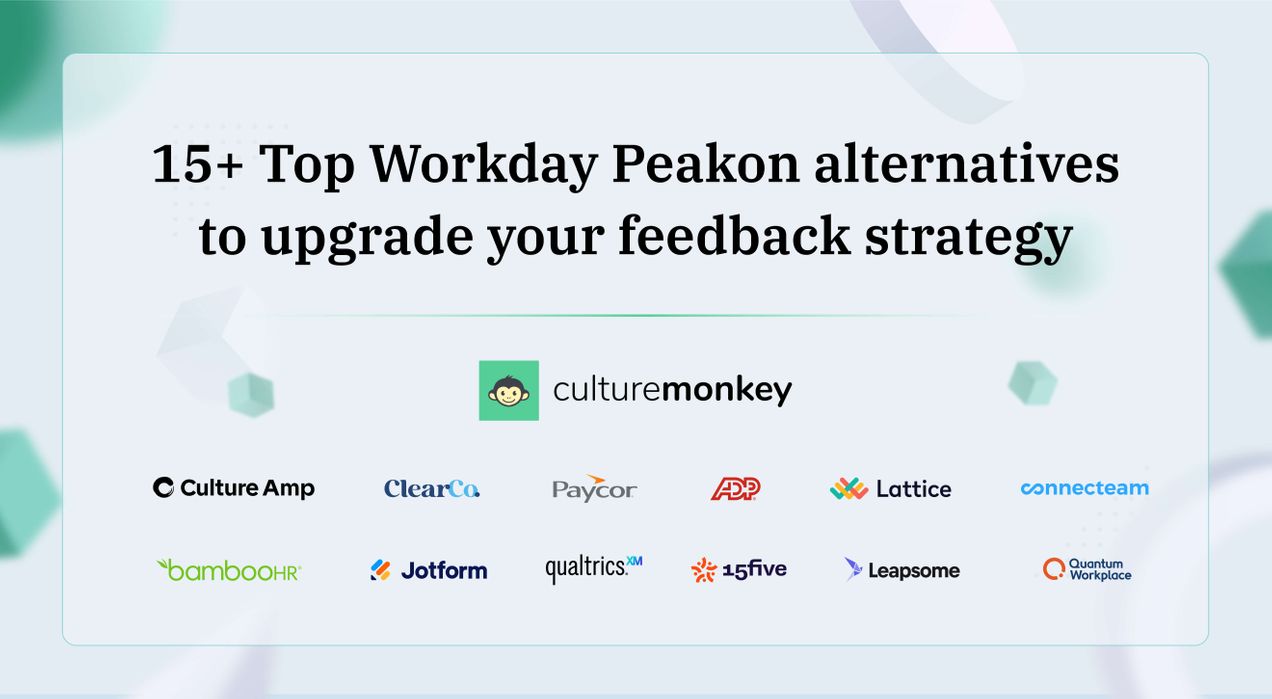How to create an effective work engagement survey: best practices, questions, and tips

Imagine you’re captaining a ship that suddenly drifts off course—your crew is missing signals, but everything on the surface looks fine. This is what managers experience when deadlines slip, and team motivation drops without an obvious cause. One leader faced this exact issue. Despite meetings and check-ins, they couldn’t pinpoint the problem. So, they turned to a work engagement survey, and the results were eye-opening: employees felt disconnected from the company’s goals. With that insight, they implemented targeted strategies that revitalized team morale and productivity—like a superhero team pulling together just in time for the final showdown.
When thoughtfully crafted, a work engagement survey can reveal where employees feel aligned and where improvements are needed. It’s not just about gathering opinions; it’s about creating a space for real feedback that drives meaningful change.
In this blog, we’ll cover the best practices, essential questions, and tips to help you create a survey that captures valuable insights and equips leadership with actionable data, fostering a culture of engagement and success.
Work engagement survey objectives

A work engagement survey for staff provides crucial insights into how connected employees feel to their work and the organization. By identifying key engagement drivers, it helps leaders create a more motivated, productive, and satisfied workforce.
Understanding these objectives can guide the creation of the next employee opinion survey that brings actionable results, ultimately improving both employee well-being and business outcomes. Here are the primary objectives of a work engagement survey:
1. Measure employee satisfaction
This objective helps determine how content employees are with their job roles, responsibilities, and the overall work environment. A thorough understanding of employee satisfaction can lead to improved morale, reduced turnover, and a clearer view of where teams are thriving or struggling. It provides a foundation for measuring workplace well-being and addressing issues early.
2. Identify engagement drivers
Knowing what motivates or demotivates employees is crucial for building a strong, highly engaged, team. This objective focuses on uncovering the specific factors—like leadership support, recognition, or career development opportunities—that influence employee engagement. With this data, organizations can enhance the drivers that contribute to higher motivation and address those that may be causing disengagement.
3. Gauge alignment with company values
Employees who connect with the company’s mission and values tend to be more engaged and loyal. This objective assesses whether employees understand and embrace the organization’s purpose and culture. Misalignment between personal and the company mission and values can lead to decreased engagement, so it’s important to ensure employees feel connected to the larger organizational vision.
4. Spot areas for improvement
A key goal of a work engagement survey is to highlight areas where engagement is lacking or where processes could be improved. This might involve addressing communication gaps, lack of growth opportunities, or inefficient management practices. Identifying these pain points allows for targeted solutions that can boost overall employee engagement levels and productivity.
5. Enhance communication
Surveys give employees an open forum to express concerns and provide honest feedback, which can be essential for fostering trust. By encouraging transparent communication, this objective helps build a culture of openness, where employees feel heard and valued. This feedback loop strengthens relationships between teams and leadership.
How can employee engagement be measured in surveys?

Employee engagement surveys offer a structured way to assess how connected, motivated, and satisfied employees feel in their roles.
By using specific questions and metrics, organizations can gain insights into the overall engagement levels and pinpoint areas for improvement. Effective measurement in surveys relies on a combination of qualitative and quantitative data to provide a comprehensive view of engagement.
- Engagement scales: Use likert scales to measure levels of agreement on statements related to job satisfaction, motivation, and connection to company values.
- Employee net promoter score (ENPs): Ask employees how likely they are to recommend the company as a great place to work, providing an overall sense of loyalty and satisfaction.
- Open-ended feedback: Include sections for employees to share qualitative insights about their experience, offering deeper context beyond Numbers.
- Frequency of participation in company activities: Track how often employees engage in optional activities, such as training programs, Team-building exercises, or company events, as a gauge of active involvement.
- Alignment with company goals: Measure how well employees understand and align with the organization’s mission, vision, and objectives, indicating a deeper sense of purpose at work.
- Job role satisfaction: Assess how satisfied employees feel in their current role, which directly impacts engagement and overall productivity.
- Recognition and feedback: Gauge how often employees feel recognized for their contributions and how regularly they receive constructive feedback from managers.
- Work-life balance: Measure employees’ perceptions of their ability to maintain a healthy work-life balance, as burnout can significantly reduce engagement levels.
7 Benefits of work engagement survey at work

Work engagement surveys provide invaluable insights into the health of an organization’s culture, productivity, and employee morale. Regularly conducting these surveys empowers leaders to make informed decisions based on real-time feedback from employees.
By understanding engagement levels, organizations can foster a more motivated, committed workforce and drive overall performance.
1. Improves employee satisfaction
Engagement surveys allow organizations to identify factors that affect job satisfaction, such as work-life balance, recognition, or career development opportunities. By addressing these concerns, leadership can enhance the employee experience, leading to happier and more fulfilled employees who are more likely to stay Long-term and contribute positively to the organization’s goals.
2. Boosts productivity
Engaged employees are more motivated to go the extra mile in their roles, leading to higher levels of productivity. Surveys help identify obstacles to engagement, such as lack of resources or unclear communication, enabling leaders to remove barriers and create an environment where employees can thrive and work more efficiently.
3. Reduces turnover
High employee turnover can be costly, both financially and in terms of Team morale. Engagement surveys help uncover the reasons behind disengagement, such as poor leadership or lack of career growth. By addressing these pain points, organizations can reduce turnover rates, retain top talent, and maintain a more stable, cohesive Team.
4. Enhances company culture
Employee feedback surveys are the key to understanding how well the company’s values and culture are resonating with the workforce. Positive company culture can lead to increased loyalty and stronger employee-employer relationships, creating a work environment where people feel aligned with the organization’s mission and are proud to be part of it.
5. Increases transparency
Team engagement surveys give employees a safe space to voice their opinions and concerns. This promotes a culture of openness and transparency, where employees feel their feedback is valued. When leadership responds to this feedback, it strengthens trust within the organization and fosters a more collaborative atmosphere.
6. Promotes leadership effectiveness
Surveys can highlight gaps in leadership effectiveness, such as communication issues, unclear expectations, or lack of support. By using the insights from these surveys, leaders can adjust their approaches, provide better guidance, and improve their relationships with team members, leading to more, highly engaged employees, and high-performing teams.
7. Drives innovation
Engagement surveys encourage employees to share ideas and suggestions for improving processes or solving challenges. This opens up opportunities for innovation, as employees often have unique perspectives on how to enhance workflow, team collaboration, or customer service. Organizations that act on these insights can gain a competitive edge and continuously improve operations.
How to create an effective work engagement survey: A step-by-step guide

Creating a work engagement survey requires careful planning to ensure that it captures meaningful insights while being easy for employees to complete.
A well-structured survey should ask the right questions, be designed to encourage honest feedback and provide actionable data for leadership. Follow these steps to craft a survey that engages your employees and generates valuable feedback for organizational improvement.
- Define the survey objectives: Clearly outline the goals of your survey—whether it’s to measure engagement, identify problem areas, or gather feedback on specific initiatives.
- Choose the right questions: Use a mix of question types—like ratings, multiple choice, and open-ended—to cover key areas such as job satisfaction, leadership, and workplace culture.
- Keep the survey concise: Limit the survey to 20-30 questions to avoid survey fatigue and ensure higher response rates. Focus on the most relevant topics.
- Pilot the survey: Test the survey with a small group to identify any confusing questions or technical issues before rolling it out company-wide.
- Ensure anonymity and confidentiality: Guarantee anonymity to encourage honest, open feedback from employees.
- Promote the survey: Use internal communication channels to highlight the importance of the survey and encourage participation.
- Analyze the data effectively: Review both quantitative and qualitative responses to identify trends, strengths, and areas for improvement.
- Communicate the findings: Share Key results with employees to Foster transparency and show that their input is valued.
- Take action based on results: Develop and implement plans based on the feedback to improve engagement.
- Follow-up: Conduct follow-up surveys to track progress and ensure ongoing engagement.
12 Work engagement survey best practices to create an engaging survey

Creating an engaging work engagement survey goes beyond just asking the right questions. To truly capture meaningful insights, your employee engagement survey questions need to be thoughtfully designed, easy to navigate, and effectively communicated.
Here are 12 best practices that can help you create a survey that not only gathers data but also boosts employee participation and engagement.
- Start with a clear purpose: Be transparent about why the survey is being conducted. Clearly communicate to employees how their feedback Will be used to improve the workplace and why their participation is important.
- Use simple, straightforward language: Avoid complex terminology or jargon in your questions. Keep the language clear and simple to ensure that every employee, regardless of role or experience, understands the questions.
- Focus on key engagement areas: Ensure that your questions cover the core aspects of engagement, such as leadership, recognition, career development, and workplace culture, but avoid making the survey too broad.
- Ensure accessibility across devices: Make sure your survey can be easily completed on any device—desktop, tablet, or mobile. This flexibility Will increase participation by allowing employees to fill out the survey at their convenience.
- Use demographic questions thoughtfully: Include optional demographic questions (such as department or years of service) to help break down results, but ensure anonymity to avoid making employees feel uncomfortable.
- Provide a progress indicator: Adding a progress bar to the survey lets employees know how much of the survey remains, helping them stay motivated to complete it.
- Test the survey for usability: Before launching, test the survey for clarity, ease of navigation, and technical issues. Gather feedback from a small group of employees to ensure everything works smoothly.
- Create a safe space for feedback: Foster an environment where employees feel comfortable sharing their thoughts without fear of retribution. Clearly communicate that all feedback is anonymous and Will be treated with confidentiality, encouraging more open and honest responses.
- Provide context for each question: When appropriate, include brief explanations or context for questions, particularly if they relate to specific initiatives or organizational changes. This helps employees understand the relevance of each question and provides clarity, leading to more thoughtful responses.
- Use engaging visuals: Incorporate visuals like graphics, icons, or colors to make the survey more appealing. Engaging design elements can help maintain employees’ attention and improve their overall experience when completing the survey.
- Consider timing and frequency: Choose an optimal time to launch the survey, avoiding peak work periods or major company events that could affect participation. Additionally, establish a regular cadence for surveys—such as bi-annually or annually—to track progress over time without causing survey fatigue.
- Celebrate participation and outcomes: After the survey concludes, acknowledge and celebrate participation. Share the overall response rate and recognize teams that contributed significantly. Following this, communicate the key findings and any actions taken in response to the feedback, reinforcing that employee input is valued and impactful.
How long should an employee engagement survey take?

Determining the appropriate length of an employee engagement survey is crucial for maximizing participation and obtaining meaningful feedback. Ideally, a survey should take between 10 to 15 minutes to complete.
This timeframe allows employees to thoughtfully answer questions without feeling rushed or fatigued, ensuring higher-quality responses while maintaining their engagement throughout the process.
To achieve this optimal duration, limit the number of questions to around 20-30, focusing on the most relevant topics that align with your survey objectives. Each question should be clear and concise, avoiding unnecessary complexity.
Additionally, consider using various question types, such as multiple choice, Likert scales, and open-ended questions, to keep the survey interesting and engaging.
Timing is also essential; choose a period when employees are less likely to be overwhelmed by other responsibilities, ensuring they can dedicate time to provide thoughtful input.
After the survey, it’s beneficial to follow up with a brief pulse survey or check-in to gauge employee engagement over time without imposing a significant time commitment. By prioritizing a reasonable completion time, organizations can foster greater participation and collect valuable insights to drive engagement initiatives.
25+ Work engagement survey questions to ask in 2025

Crafting the right questions for your work engagement survey is essential for capturing the sentiments and experiences of your employees.
The questions should cover various aspects of engagement, including job satisfaction, communication, personal life, and company culture. Here are over 25+ best employee engagement survey questions to consider for your 2025 employee engagement survey:
- How satisfied are you with your current role and responsibilities?
- Do you feel that your work is valued by the organization?
- How often do you receive recognition for your contributions?
- Do you have the resources you need to perform your job effectively?
- How would you rate communication within your team?
- Do you believe the organization’s values align with your personal values?
- How often do you feel motivated to go above and beyond in your work?
- How well does your manager support your professional development?
- Do you feel comfortable sharing ideas and feedback with your team?
- How satisfied are you with your opportunities for career advancement?
- How would you rate the overall work environment?
- Do you feel that your team collaborates effectively?
- How often do you participate in team-building activities?
- Are you encouraged to take breaks and maintain work-life balance?
- How well does leadership communicate organizational changes?
- Do you believe that the company invests in employee well-being?
- How often do you receive constructive feedback on your performance?
- How confident are you in the organization's direction and goals?
- Do you feel that your work contributes to the organization's success?
- How would you describe your level of engagement with your tasks?
- How often do you participate in professional development opportunities?
- How satisfied are you with the company's approach to diversity and inclusion?
- Do you feel comfortable discussing concerns with your supervisor?
- How well does the organization adapt to employee feedback?
- Are you aware of the available employee resources and support systems?
- How often do you feel stressed or overwhelmed at work?
- Do you believe that your team is recognized for its achievements?
- How well do you feel your input is considered in decision-making?
- How likely are you to recommend this organization as a great place to work?
What to do with employee engagement survey results?

Once you have collected and analyzed the results of your employee engagement survey, the next steps are crucial for translating data into actionable insights. Begin by sharing the findings with employees in a transparent manner, highlighting both strengths and areas for improvement. This fosters trust and encourages continued participation in future surveys.
You also need to prioritize the key themes identified in the survey results. Focus on the areas that received the lowest scores or the most significant feedback from employees. Develop an action plan that outlines specific steps to address these concerns, setting clear objectives and timelines for implementation. Assign responsibility to leaders or teams to ensure accountability in executing the plan.
Communicate the action plan back to employees, detailing how their feedback will influence change. Regular updates on progress will maintain engagement and show employees that their opinions are valued and acted upon. Additionally, consider conducting follow-up surveys or pulse checks to measure the effectiveness of the changes made.
By demonstrating a commitment to improving engagement based on employee feedback, organizations can cultivate a more motivated and satisfied workforce, ultimately leading to improved productivity and retention.
Top 5 tools for conducting a work engagement survey
Conducting a work engagement survey effectively requires the right tools to streamline the process and gather actionable insights. Here are five top tools that can help organizations create and manage their employee engagement surveys well:
1. CultureMonkey
CultureMonkey is an innovative platform designed to enhance employee engagement through a wide range of customizable tools and insights. Here’s an overview of its powerful features:
- Customized, multilingual surveys: CultureMonkey allows organizations to create customized surveys in multiple languages, catering to diverse teams across regions and ensuring everyone’s voice is heard.
- User-friendly, research-backed templates: With 50+ ready-to-use templates, CultureMonkey provides research-backed survey designs that are easily customizable, saving time while addressing various engagement needs.
- Anonymous feedback for honest insights: Employees can give anonymous feedback, which encourages open communication and allows leaders to understand true sentiments without fear of reprisal.
- Actionable insights and recommendations: CultureMonkey offers AI-driven insights that highlight trends and areas of improvement, empowering leaders to take immediate action with suggested recommendations.
- Seamless HRMS integration: Integrate with popular HRMS platforms like Darwinbox, Zoho People, and Okta to streamline data collection and ensure accurate reporting across platforms.
- Benchmarking against industry standards: With industry benchmarking, organizations can compare their results with similar companies, gaining a competitive understanding of their engagement levels.
- Mobile-friendly and accessible: Designed for accessibility, CultureMonkey’s surveys work seamlessly on mobile, and employees can respond on platforms like Slack, Teams, and WhatsApp.
2. SurveyMonkey
A popular tool for creating surveys, SurveyMonkey offers a range of customizable templates tailored for employee engagement. Its intuitive interface allows users to design, distribute, and analyze surveys with ease.
3. Qualtrics
Qualtrics provides a comprehensive employee engagement platform that includes powerful survey capabilities. It offers advanced analytics, benchmarking, and automated reporting, allowing organizations to understand engagement drivers deeply.
4. TinyPulse
TinyPulse focuses on continuous employee feedback through quick, anonymous pulse surveys. This tool allows organizations to gather insights frequently and understand employee sentiment in real time. With features like peer recognition and feedback sharing, TinyPulse fosters a culture of openness and engagement.
5. Officevibe
Officevibe helps organizations assess employee engagement through weekly pulse surveys and detailed reports. The platform focuses on key engagement drivers such as team dynamics, leadership effectiveness, and employee satisfaction. With actionable insights and customizable questions, Officevibe helps organizations create a more engaged workforce while enhancing communication between employees and management.
Conclusion
Conducting a work engagement survey is a vital step for organizations aiming to understand and enhance employee satisfaction and performance.
By thoughtfully crafting survey questions, implementing best practices, and leveraging powerful employee engagement survey tools like CultureMonkey, organizations can gather meaningful insights into their workforce's sentiments. The feedback received from these surveys not only identifies areas for improvement but also fosters a culture of transparency and communication.
By taking actionable steps based on survey results, organizations can build a more engaged and motivated workforce, leading to improved retention and overall business success.
As you embark on this journey to enhance engagement, remember that continuous feedback and follow-up surveys are essential to measure progress and adapt strategies as needed. With the right approach and tools at your disposal, your organization can create a thriving workplace culture where employees feel valued and empowered.
FAQs
1. What are good questions for a work engagement survey?
Good questions for a work engagement survey should cover key areas such as job satisfaction, recognition, communication, and career development. Examples include: “How satisfied are you with your current role?” and “Do you feel valued by your team?” Using a mix of rating scales, multiple-choice, and open-ended questions can provide comprehensive insights into employee sentiments and engagement levels.
2. How often should work engagement surveys be conducted?
Work engagement surveys should typically be conducted bi-annually or annually to effectively track employee sentiment and engagement over time. This frequency allows organizations to assess changes in employee attitudes without overwhelming them with constant surveys. Additionally, conducting shorter pulse surveys in between can help maintain an ongoing dialogue about engagement and quickly address any emerging issues or concerns.
3. How do work engagement surveys improve employee retention?
Work engagement surveys improve employee retention by identifying concerns and areas for improvement within the organization. When employees feel heard and see that their feedback leads to actionable changes, they are more likely to remain engaged and committed to the organization. This proactive approach boosts morale and fosters a positive workplace culture that encourages loyalty and reduces turnover.
4. What tools can I use to create a work engagement survey?
Several tools can facilitate the creation of effective work engagement surveys. CultureMonkey offers customized surveys and real-time feedback capabilities. Other popular options include SurveyMonkey for user-friendly templates, Qualtrics for advanced analytics, TinyPulse for quick pulse surveys, and Officevibe for weekly engagement checks. These tools help organizations design, distribute, and analyze surveys efficiently, ensuring meaningful insights.
5. What is the best way to analyze employee engagement survey results?
The best way to analyze employee engagement survey results is to employ both quantitative and qualitative methods. Begin by calculating response rates and average scores for closed-ended questions to identify trends. For open-ended responses, categorize feedback into themes to uncover insights. Prioritize findings based on urgency and impact, then create an action plan to address areas for improvement.



